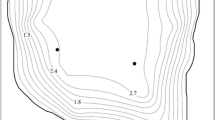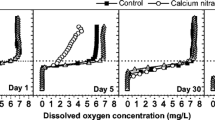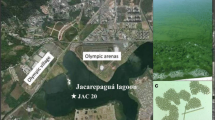Abstract
Effects of chironomids on sediment–water exchange of nutrients and their impact on the efficiency of Phoslock® (a lanthanum (La) modified clay for phosphorus (P) removal in freshwater systems) were tested during a 35 days incubation experiment with sediment cores from a Danish eutrophic Lake. Four different sediment treatments with increased or natural densities of chironomids in combination with Phoslock® were used: (1) Control + (2) Chironomids + (3) Phoslock + (4) Chironomids & Phoslock. Nutrients in the overlying water were followed during the incubation period. The treatments with Phoslock reduced P in the overlying water significantly compared to the control treatment. In addition, the chironomids significantly increased sediment nitrate uptake as well as sediment ammonium release. After the incubation period, a sequential extraction of P and La was conducted. The Phoslock treatment led to a reduction of the iron-bound P pool in the sediment and a higher HCl-extractable P pool. Also, most La was recovered in the HCl extract, indicating that P became strongly bound to La in the Phoslock matrix. Sequential extraction of pure Phoslock demonstrated that the bentonite matrix of Phoslock contained redox sensitive iron, and that ammonium might be released from Phoslock, when dispersed in water.



Similar content being viewed by others
References
Andersen, F. Ø. & H. S. Jensen, 1991. The influence of chironomids on decomposition of organic matter and nutrient exchange in a lake sediment. Verhandlungen Internationale Vereinigung für Theoretische und Angewandte Limnologie 24: 2055–3051.
Andersen, F. Ø., M. Jørgensen & H. S. Jensen, 2006. The influence of Chironomus plumosus larvae on nutrient fluxes and phosphorus fractions in aluminum treated lake sediment. Water, Air, and Soil Pollution: Focus 6: 101–110.
Boers, P., J. Vanderdoes, M. Quaak & J. Vandervlugt, 1994. Phosphorus fixation with iron(III)chloride – a new method to combat internal phosphorus loading in shallow lakes. Archiv für Hydrobiologie 129: 339–351.
Cooke, G. D., R. T. Heath, R. H. Kennedy & M. R. Mccomas, 1982. Change in lake trophic state and internal phosphorus release after aluminum sulfate application. Water Resources Bulletin 18: 699–705.
Cooke, G. D., E. B. Welch, S. A. Peterson & S. A. Nichols, 2005. Restoration and management of lakes and reservoirs. 3rd ed. CRC Press, Boca Raton.
Douglas, G. B., J. A. Adeney & M. S. Robb, 1999. A novel technique for reducing bioavailable phosphorus in water and sediments. International Association Water Quality Conference on Diffuse Pollution: 517–523.
Egemose, S., K. Reitzel, F. Ø. Andersen & M. R. Flindt, 2010. Chemical lake restoration products: sediment stability and phosphorus dynamics. Environmental Science & Technology 44: 985–991.
Fukuhara, H. & M. Sakamoto, 1987. Enhancement of inorganic nitrogen and phosphate release from lake sediment by tubificid worms and chironomid larvae. Oikos 48: 312–320.
Gallep, G. W., 1979. Chironomid influence on phosphorus release in sediment-water microcosms. Ecology 60: 547–556.
Geurts, J. J. M., P. A. G. van de Wouw, A. J. P. Smolders, J. G. M. Roelofs & L. P. M. Lamers, 2011. Ecological restoration on former agricultural soils: feasibility of in situ phosphate fixation as an alternative to top soil removal. Ecological Engineering 37: 1620–1629.
Gibbs, M., C. W. Hickey & D. Özkundakci, 2011. Sustainability assessment and comparison of efficacy of four P-inactivation agents for managing internal phosphorus loads in lakes: sediment incubations. Hydrobiologia 658: 253–275.
Granéli, W., 1979. The influence of Chironomus plumosus larvae on the exchange of dissolved substances between sediment and water. Hydrobiologia 66: 149–159.
Haghseresht, F., S. Wang & D. D. Do, 2009. A novel lanthanum-modified benthonite, Phoslock™, for phosphate removal from wastewaters. Applied Clay Science 46: 369–375.
Hansen, K., S. Mouridsen & E. Kristensen, 1998. The impact of Chironomus plumosus larvae on organic matter decay and nutrient (N, P) exchange in a shallow eutrophic lake sediment following a phytoplankton sedimentation. Hydrobiologia 364: 65–74.
Hickey, C. W. & M. M. Gibbs, 2009. Lake sediment phosphorus release management-decision support and risk assessment framework. New Zealand Journal of Marine and Freshwater Research 43: 819–854.
Kajak, Z. & P. Prus, 2004. Time of Chironomus plumosus (L.) generations in natural conditions of lowland reservoir. Polish Journal of Ecology 52: 211–222.
Koroleff, F., 1983. Determination of nutrients. In Grasshoff, K, M. Ehrhardt & K. Kremling (eds), Methods of Seawater Analysis. Verlag Chemie, Weinheim, Germany: 125–139.
Lewandowski, J. & M. Hupfer, 2005. Effect of macrozoobenthos on two-dimensional small-scale heterogeneity of pore water phosphorus concentrations in lake sediments: a laboratory study. Limnology and Oceanography 50: 1106–1118.
Lewandowski, J., C. Laskov & M. Hupfer, 2007. The relationship between Chironomus plumosus burrows and the spatial distribution of pore-water phosphate, iron and ammonium in lake sediments. Freshwater Biology 52: 331–343.
Lurling, M. & E. J. Faassen, 2012. Controlling toxic cyanobacteria: effects of dredging and phosphorus-binding clay on cyanobacteria and microcystins. Water Research 46: 1447–1459.
Meis, S., B. M. Spears, S. C. Maberly, M. B. O’Malley & R. G. Perkins, 2011. Sediment amendment with Phoslock® in Clatto Reservoir (Dundee, UK): investigating changes in sediment elemental composition and phosphorus fractions. Journal of Environmental Monitoring 93: 185–193.
Paludan, C. & H. S. Jensen, 1995. Sequential extraction of phosphorus in freshwater wetland and lake sediment: significance of humic acids. Wetlands 15: 365–373.
Pelegrí, S. P. & T. H. Blackburn, 1996. Nitrogen cycling in lake sediments bioturbated by Chironomus plumosus larvae, under different degrees of oxygenation. Hydrobiologia 325: 231–238.
Psenner, R. & R. Pucsko, 1988. Phosphorus fractionation: advantages and limits of the method for the study of sediment P origins and interactions. Archiv für Hydrobiologie–Beiheft Ergebnisse der Limnologie 30: 43–59.
Reitzel, K., 2005. Separation of aluminum bound phosphate from iron bound phosphate in freshwater sediments by a sequential extraction procedure. In Serrano, L. & H. L. Golterman (eds), Phosphates in Sediments. Backhuys Publishers, Leiden: 109–117.
Reitzel, K., J. Hansen, F. Ø. Andersen, K. S. Hansen & H. S. Jensen, 2005. Lake restoration by dosing aluminum relative to mobile phosphorus in the sediment. Environmental Science and Technology 39: 4134–4140.
Ross, G., F. Haghseresht & T. E. Cloete, 2008. The effect of pH and anoxia on the performance of Phoslock™, a phosphorus binding clay. Harmfull Algae 7: 545–550.
Stief, P., 2007. Enhanced exoenzyme activities in sediments in the presence of deposit-feeding Chironomus riparius larvae. Freshwater Biology 52: 1807–1819.
Svensson, J. M., 1997. Influence of Chironomus plumosus larvae on ammonium flux and denitrification (measured by acetylene blockage- and the isotope pairing-technique) in eutrophic lake sediment. Hydrobiologia 346: 157–168.
Tátrai, I., 1992. Oxygen consumption and ammonia excretion of herbivorous chironomid larvae in Lake Balaton. Hydrobiologia 96: 129–135.
Acknowledgments
This work was supported by a Villum Kann Rasmussen Centre of Excellence: Centre for Lake Restoration (CLEAR) and a grant from the Danish Natural Science Research Council. In addition, we thank Yohana M. Velasco-Santamaría for help with the statistics.
Author information
Authors and Affiliations
Corresponding author
Additional information
Handling editor: David Philip Hamilton
Rights and permissions
About this article
Cite this article
Reitzel, K., Lotter, S., Dubke, M. et al. Effects of Phoslock® treatment and chironomids on the exchange of nutrients between sediment and water. Hydrobiologia 703, 189–202 (2013). https://doi.org/10.1007/s10750-012-1358-8
Received:
Revised:
Accepted:
Published:
Issue Date:
DOI: https://doi.org/10.1007/s10750-012-1358-8




